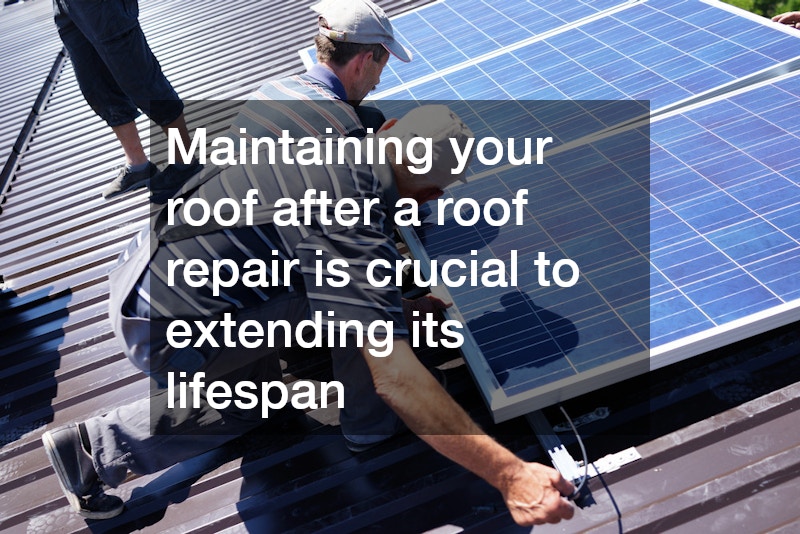Maintaining your roof after a roof repair is crucial to extending its lifespan and ensuring your home remains protected from the elements. Many homeowners overlook this essential aspect, often leading to more costly repairs down the line. In this article, we will explore practical steps you can take to care for your roof post-repair, ensuring it remains in top condition for years to come.
Understanding Your Roof Repair
First and foremost, it’s vital to understand what type of roof restoration has been performed. Whether it was a patch for a leak, replacement of shingles, or any other type of repair, knowing the specifics will help you tailor your maintenance approach.
Discuss with your roofing contractor the details of the repair, including the materials used and any vulnerabilities that may still exist. This foundational knowledge will enable you to monitor your roof more effectively.
Regular Inspections
One of the most important steps in roof maintenance after a roof restoration is conducting regular inspections. Aim to inspect your roof at least twice a year, ideally in the spring and fall. Look for any signs of damage, such as loose shingles, cracks, or areas where debris has accumulated. Early detection of problems can help you address issues before they escalate, saving you from further costly repairs. Additionally, consider hiring a professional to perform a thorough inspection every few years.
Keep Gutters Clean
Gutters play a critical role in maintaining the health of your roof. After a roof restoration, it’s essential to keep your gutters clean and free from debris. Clogged gutters can lead to water pooling on your roof, which can compromise the integrity of your recent repairs. Regularly remove leaves, twigs, and other debris from your gutters to ensure water flows freely. Investing in gutter guards can also help reduce the amount of debris that enters your gutters.
Trim Overhanging Branches
If you have trees near your home, it’s essential to maintain them properly, especially after a roof repair. Overhanging branches can cause damage to your roof by scraping against it during wind or stormy weather. They can also drop leaves and debris onto your roof, leading to potential blockages in your gutters. Regularly trim back branches that are too close to your roof to mitigate this risk and protect your investment.
Maintain Proper Ventilation
Proper ventilation is key to the longevity of your roof. After a roof repair, ensure that your attic has adequate ventilation. Poor ventilation can lead to heat and moisture buildup, which can cause damage to your roof structure and the newly repaired areas. Inspect your vents and consider installing additional ones if necessary. A well-ventilated attic will help keep your roof in good condition and improve energy efficiency.
Monitor Interior Spaces
Keep an eye on the interior of your home, particularly ceilings and walls, for any signs of leaks or moisture. If you notice any stains, water marks, or mold, it may indicate that your roof repair was not completely effective or that a new issue has arisen. Addressing these signs quickly can prevent further damage and costly repairs down the line.
Protect from Extreme Weather
After a roof repair, it’s crucial to protect your roof from extreme weather conditions. While you can’t control the weather, you can take proactive measures to safeguard your roof. For instance, if you live in an area prone to heavy snowfall, ensure that snow is cleared off your roof regularly to prevent added weight and potential leaks. Similarly, during hurricane season, check that your roof is secure and that any loose materials are properly fastened.
Schedule Professional Maintenance
While DIY inspections and maintenance are valuable, nothing beats the expertise of a professional. Schedule routine maintenance with a reputable roofing contractor to ensure your roof remains in optimal condition. Professionals can spot issues that may be overlooked and provide the necessary repairs or preventative measures. Regular maintenance can significantly extend the life of your roof and your roof repair investment.
Document All Repairs
Maintaining a detailed record of all roof restorations and maintenance activities is essential. Keep track of when repairs were made, what work was done, and any recommendations from your contractor. This documentation can be invaluable for future reference, particularly if you decide to sell your home. Potential buyers will appreciate knowing that the roof has been well-maintained and that repairs were documented.
Invest in Quality Materials
If your roof restoration involved the replacement of materials, consider investing in high-quality options that offer longevity and durability. While the initial cost may be higher, premium materials can save you money in the long run by reducing the frequency of repairs. Discuss options with your roofing contractor to find the best materials that fit your budget and needs.
Maintaining your roof after a roof repair is crucial for protecting your home and maximizing the lifespan of your investment. By understanding the specifics of your repair, conducting regular inspections, keeping your gutters clean, and taking preventative measures against weather-related issues, you can ensure that your roof remains in excellent condition. Additionally, documenting all repairs and working with professionals will further enhance your roof’s longevity. Remember, a proactive approach to roof maintenance today can save you time, money, and stress in the future.
.




